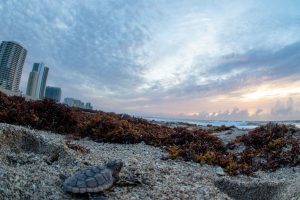Last week I saw a listing for a Sea Turtle Sunrise Walk with Dr. Larry Woods (a local sea turtle researcher). I debated it for a bit wondering whether it really would be worth doing, but eventually decided that this is precisely what the whole digital nomad thing is about and got myself signed up. Even if it ended up being a morning walk on the beach while getting some knowledge from a sea turtle expert, I figured I should at least give it a try. I honestly did not think I would actually see any baby sea turtles on this walk and expected it to be just walking along the beach and looking at nests (which as you’ll see just look like some tracks in the sand). Instead, as we were checking in at the dive shop that hosted the walk (Pura Vida Divers) one of the participants spotted a baby sea turtle in the middle of the road! Things quickly got interesting and the decision to sign up for this event paid off!
The event then turned into a bit of a rescue effort. We found about 20 or so baby turtles that were headed completely the wrong direction. Research has indicated that when baby turtles emerge from their nests, many of them seem to be confused by the lights of buildings and such and head in the wrong direction. Normally my wildlife photography, I try to avoid showing the human influences, but in this case I was intentionally including the buildings in the frame for this reason.
We eventually found the nest where we believe that these turtles emerged from, and though the shot does not show it clearly, only one set of tracks heads in the correct direction, all the others headed in-land towards the buildings.
We also found a couple new nests that were made the night before. This one below clearly shows the trail the mother turtle made coming up onto the beach and then returning to the sea. Dr. Woods – or as he introduces himself, Larry the Turtleman – explained that the mother turtles will lay about 100 eggs per nest and that she will create multiple nests each year, laying eggs every couple weeks. Nesting season runs from March till October with most species having 60 – 90 day incubation periods.
Every morning the researchers walk the beach and check for new nests like the one above, or signs of a nest that has had babies emerge. When they find one where the babies have emerged (I say emerged because apparently they hatch and may or may not emerge from the nest at the same time or up to a couple days later), they mark the date and then three days later they excavate the nest to count the number of eggs that hatched, any that did not hatch, and to search for any stragglers that have not yet left the nest.
I know going into this I was not expecting to even see a baby sea turtle and I was doubting that even if I did that I would get any good photos. Instead, I ended up with some rather nice photos and the rewarding experience of saving a few sea turtles that likely would have perished because of human influences.
Truthfully, a couple of the photos are a little soft on the focus, and I will have to make a point to try and get up that way a couple more times, both to try again for some better photos and to also hopefully help a few more turtles.
Tune in again tomorrow for a few more photos and a short video…



Jordan
July 15, 2021 at 10:25amGreat shots!
Andrew McMillen
July 15, 2021 at 11:46amNice shots Will! That’s great you were able to see some baby sea turtles!